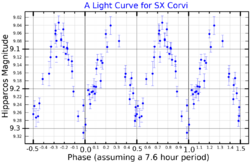Astronomy:SX Corvi
| Observation data Equinox J2000.0]] (ICRS) | |
|---|---|
| Constellation | Corvus |
| Right ascension | 12h 40m 15.04406s[2] |
| Declination | −18° 48′ 00.9336″[2] |
| Apparent magnitude (V) | 8.99 - 9.25 [3] |
| Characteristics | |
| Spectral type | F7V[3] |
| Variable type | W UMa |
| Astrometry | |
| Radial velocity (Rv) | 8.71 ± 0.94 km/s |
| Proper motion (μ) | RA: 39.16 ± 1.21 mas/yr Dec.: -6.07 ± 0.80 mas/yr |
| Parallax (π) | 10.94 ± 1.18[4] mas |
| Distance | approx. 300 ly (approx. 91 pc) |
| Details | |
| Age | 7.32 ± 0.97[5] Gyr |
| Other designations | |
| Database references | |
| SIMBAD | data |
SX Corvi is an eclipsing binary star system in the constellation Corvus, ranging from apparent magnitude 8.99 to 9.25 over 7.6 hours.[3] The system is a contact binary also known as a W Ursae Majoris variable, where the two component stars orbit closely enough to each other for mass to have been transferred between them—in this case the secondary having transferred a large amount of mass to the primary.[5]
Yildiz and colleagues estimated the age of the system at 7.32 ± 0.97 billion years based on study of the properties of the system and estimated rate of mass transfer. They found the current masses of the primary and secondary to be 1.25 ± 0.04 and 0.10 ± 0.01 solar masses respectively, from their original masses of 0.72 ± 0.02 and 1.68 ± 0.05 solar masses.[5]
References
- ↑ "Light Curve". ESA. https://www.cosmos.esa.int/web/hipparcos/java-tools/light-curve.
- ↑ 2.0 2.1 "SX Crv -- Eclipsing binary of W UMa type (contact binary)". http://simbad.u-strasbg.fr/simbad/sim-id?Ident=SX+Crv&NbIdent=1&Radius=2&Radius.unit=arcmin&submit=submit+id. Retrieved 21 July 2015.
- ↑ 3.0 3.1 3.2 Watson, Christopher (19 April 2012). "SX Corvi". The International Variable Star Index. American Association of Variable Star Observers. http://www.aavso.org/vsx/index.php?view=detail.top&oid=10694. Retrieved 21 July 2015.
- ↑ van Leeuwen, F. (2007). "Validation of the New Hipparcos Reduction". Astronomy and Astrophysics 474 (2): 653–64. doi:10.1051/0004-6361:20078357. Bibcode: 2007A&A...474..653V.
- ↑ 5.0 5.1 5.2 Yildiz (2014). "Origin of W UMa-type contact binaries - age and orbital evolution". Monthly Notices of the Royal Astronomical Society 437 (1): 185–94. doi:10.1093/mnras/stt1874. Bibcode: 2014MNRAS.437..185Y.
 |


